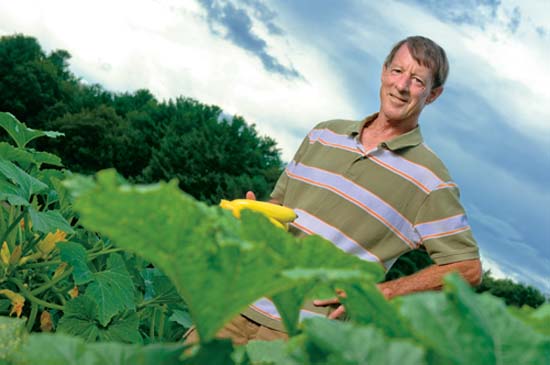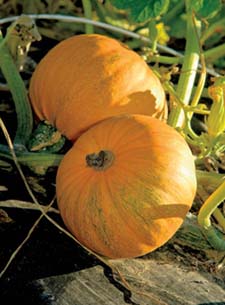 |
 |
| current issue |  |
past issues |  |
send a letter/news |  |
address update |  |
advertise |  |
about us |  |
alumni home |
Features
|
The Matchmaker
Brent Loy has introduced hundreds of plants to their perfect mates—and the birds and the bees had nothing to do with it. By Kristin Waterfield Duisberg |
Easy to print version Make a comment |
Brent Loy is on a quest for perfection.
On a sultry August morning, he stands in the middle of a field at Kingman Farm, surrounded by rows of low green plants whose broad leaves frame burgeoning fruits. He surveys the scene with an intensity one might not expect from a man surrounded by cantaloupes. But the boyish-looking professor, a plant biologist at UNH for almost 45 years, is not looking for something as simple as the ripest melon among the dozen or so that lie within arm's reach. What he's looking for is a cantaloupe that grows quickly, continues to ripen once picked, will stay ripe without spoiling for up to a week, and is high in sugar, and sweet and flavorful. When he finds it, he says, it will revolutionize the melon market. He knows the fruit he's looking for is not in his field today, but there's a decent chance its parent—or grandparent—might be.
 Lisa Nugent/UNH Photographic Services
Lisa Nugent/UNH Photographic ServicesVINE CROP: J. Brent Loy with Slick Pik summer squash, above. |
Since the late 1960s, Loy has been UNH's "plant guy," a classically trained plant geneticist whose life's work has been breeding better plants. Focusing on vine crops in the gourd family, called Cucurbitaceae, he has developed hundreds of successful cultivars, more than 50 of which have become seed varieties for commercial sale. The catalogs used by backyard gardeners, as well as commercial farmers, are filled with the names of his creations: Earligold, Earliqueen, Passport, Sarah's Choice and Halona melons; Pik-aPie, Snackjack and Prankster pumpkins; Autumn Cup, Honey Bear and Slick Pik squash. Indeed, in the world of Cucurbitaceae, it would be hard to find a bigger name than that of J. Brent Loy—not that he's one to tout his own credentials. "I just like to farm," he says with a shrug.
Loy has always liked to farm. Born and raised in the Salt Lake City suburb of Bountiful, he knew from the age of 6 or 7 that he wanted to be a farmer, and by 9 he had secured his first summer farming job, working as a picker for a local vegetable grower. By 12 he had advanced to weeding onions and bunching radishes, and from 14 on he was a full-time summer farmhand, who took on some of the less savory jobs—like shoveling manure out of pig pens—once the harvest was over.
 Lisa Nugent/UNH Photographic Services
Lisa Nugent/UNH Photographic Services
|
Undaunted by the hard work, Loy took his love of farming to Oklahoma State University, where he earned a bachelor's degree in horticulture in 1963. For his master's and doctorate in genetics at Colorado State University, he worked with the cucurbits that would later become the focus of his career.
Stretching back to Gregor Mendel and his pea plant experiments, which are still used today to teach high school biology students about dominant and recessive genes, nearly all genetic studies start with plants. This is because plants propagate quickly, and the success of crosses—whether or not desired genetic traits are expressed by the offspring—is generally quite easy to determine. "From the get-go, I was just really interested in the way you could create something that was better, and better in ways that were both visual and quantifiable, essentially with your own hands," he says. Unlike genetic engineering, which involves modifying DNA, classical plant breeding requires careful selection for desired traits over time, although Loy notes that an occasional lucky mutation can send your work in a direction you didn't expect.
When Loy arrived at UNH in 1967, his first project was to work with the university's existing lines of blue hubbard, buttercup and golden delicious squash. These so-called processing squashes are grown for yield and not just for eating fresh. As vine cucurbits, they need a lot of room to grow, so a more compact bush plant means more plants per row and thus more raw material for canned squash and pie filling and baby food.
"It maybe sounds funny, but a lot of times 'better' is about developing what's the most useful and not necessarily what's the most flavorful or the most beautiful or what have you," Loy explains. "The fun comes in trying to maximize other qualities like flavor and nutrition without sacrificing the characteristics that the growers most want."
Page: 1 2 3 4 Next >
Easy to print version
blog comments powered by Disqus
